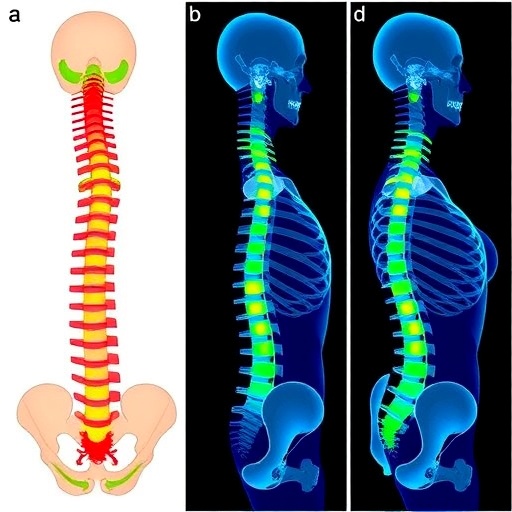In a groundbreaking study published in the prestigious journal “Annals of Biomedical Engineering,” researchers have embarked on an intricate journey to explore the biomechanics of spinal deformity correction. The study, led by a team including Vergari, Persohn, and Wolff, presents a detailed finite element analysis that meticulously compares various bipolar construct configurations. The significance of this research extends beyond mere academic curiosity; it has potential implications for surgical practices that aim to restore health and improve the quality of life for countless individuals suffering from adult spinal deformities.
Spinal deformities, such as scoliosis and kyphosis, can have debilitating effects on mobility and overall health. Traditionally, surgical interventions have sought to achieve alignment and stability through various fixation methods. However, the choice of surgical constructs and their configurations are crucial decisions that can influence both immediate surgical outcomes and long-term spinal health. This study provides a comprehensive analysis that aids surgeons in making informed decisions regarding the most effective configurations for bipolar constructs.
At heart, the researchers utilized advanced finite element modeling to simulate the mechanical interactions within spinal constructs under varying loads and conditions. This computational approach allows for an in-depth understanding of how different configurations perform under realistic conditions, offering insights that are often unattainable through traditional biomechanical testing. By simulating these constructs, the authors were able to evaluate important factors such as stress distribution, load transfer, and the potential for failure, which are critical in determining the effectiveness of spinal implants.
The finite element analysis in this study encompassed a wide range of bipolar configurations, evaluating them in terms of mechanical stability and efficacy in correcting spinal curves. The researchers systematically varied parameters such as rod diameter, screw placement, and the number of fixation points to assess how these factors influence the overall performance of the spinal constructs. This comprehensive assessment not only identifies which configurations are superior in maintaining alignment but also sheds light on the biomechanics that could underlie failures in less effective systems.
A standout feature of this research is the emphasis on patient-specific modeling. As we advance towards a more personalized approach in medicine, the ability to tailor surgical interventions based on individual anatomic and deformity characteristics is increasingly recognized as a critical factor for successful outcomes. The study’s findings prompt the consideration of personalized spinal construct configurations that may allow surgeons to optimize surgical plans, potentially leading to better functional outcomes for patients.
In clinical practices, the translation of these findings into surgical protocols could revolutionize the way adult spinal deformities are treated. Surgeons may adopt configurations validated by this study, leading to improved surgical success rates and reduced postoperative complications. The research serves as a bridge between theoretical biomechanical principles and practical surgical applications, underscoring the importance of evidence-based surgery in orthopedic medicine.
Moreover, the implications of this research extend to rehabilitative considerations. Patients recovering from spinal surgery often undergo extensive rehabilitation protocols, which may be influenced by the stability and mechanical behavior of the constructs used. Understanding how different bipolar configurations respond to physiological stresses may help rehabilitation specialists design more effective recovery programs tailored to the specific needs of patients based on the constructs employed.
The authors also delve into the importance of material selection in the design of spinal constructs. The choice of materials can significantly affect the performance of these devices under load, particularly in the context of fatigue resistance and biocompatibility. As this field evolves, there is a critical need for continued research into new materials that not only offer superior mechanical properties but also promote healing and integration with biological tissues.
In the scope of this study, the authors had to contend with several limitations inherent in the finite element analysis method. While highly valuable, simulations are ultimately approximations of reality, reliant on the accuracy of input parameters and material properties. The researchers are transparent about these limitations, acknowledging that while their findings provide a solid foundation for future work, further empirical validation through in vivo studies will be essential to fully understand the complex interactions at play in spinal constructs.
As the conversation surrounding biomechanical modeling continues to evolve, this research stands as a testament to the potential of interdisciplinary collaboration among engineers, orthopedic surgeons, and medical researchers. Together, they can drive advancements that promise not only to refine surgical techniques but also to enhance patient quality of life in meaningful ways. This integrative approach may ultimately pave the way for innovations that further push the boundaries of what is possible in spinal surgery.
This transformative study serves as a call to action for the medical community. It highlights the need for ongoing research and a commitment to bridging gaps between theoretical mechanics and clinical application to achieve the best possible outcomes for patients grappling with spine deformities. By embracing new technologies and methodologies, practitioners can ensure that they are offering the most effective solutions available.
In conclusion, the comparison of different bipolar construct configurations presented by Vergari, Persohn, and Wolff represents a pivotal step in the ongoing quest to improve spinal deformity correction. Through their thoughtful approach, they have laid the groundwork for future studies that will continue to explore and expand upon these findings, ultimately delivering hope to those affected by these challenging conditions.
Subject of Research: Comparison of Different Bipolar Construct Configurations for the Correction of Adult Spine Deformity
Article Title: Comparison of Different Bipolar Construct Configurations for the Correction of Adult Spine Deformity: A Finite Element Analysis
Article References:
Vergari, C., Persohn, S., Wolff, S. et al. Comparison of Different Bipolar Construct Configurations for the Correction of Adult Spine Deformity: A Finite Element Analysis. Ann Biomed Eng (2025). https://doi.org/10.1007/s10439-025-03867-z
Image Credits: AI Generated
DOI: https://doi.org/10.1007/s10439-025-03867-z
Keywords: Adult spine deformity, bipolar construct configurations, finite element analysis, spinal surgery, biomechanical modeling, patient-specific interventions, surgical protocols, rehabilitation strategies.




